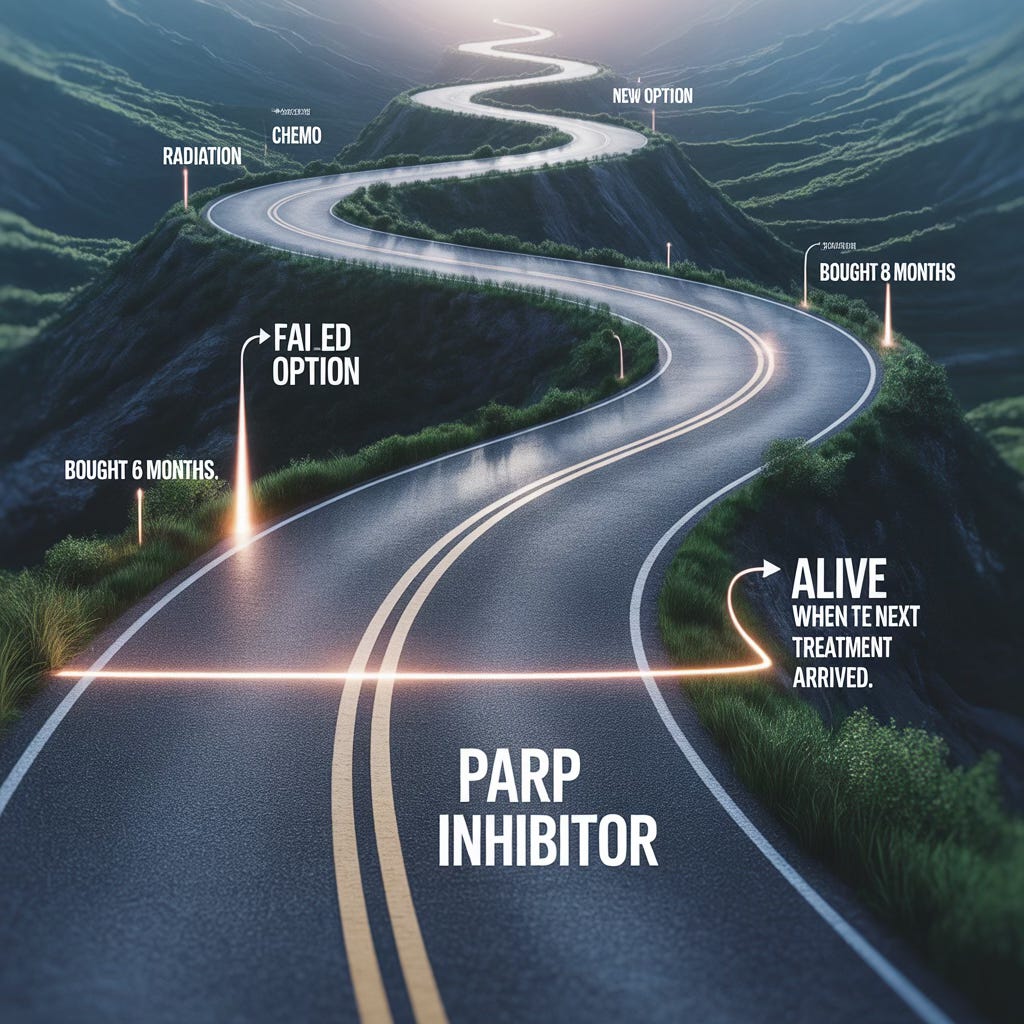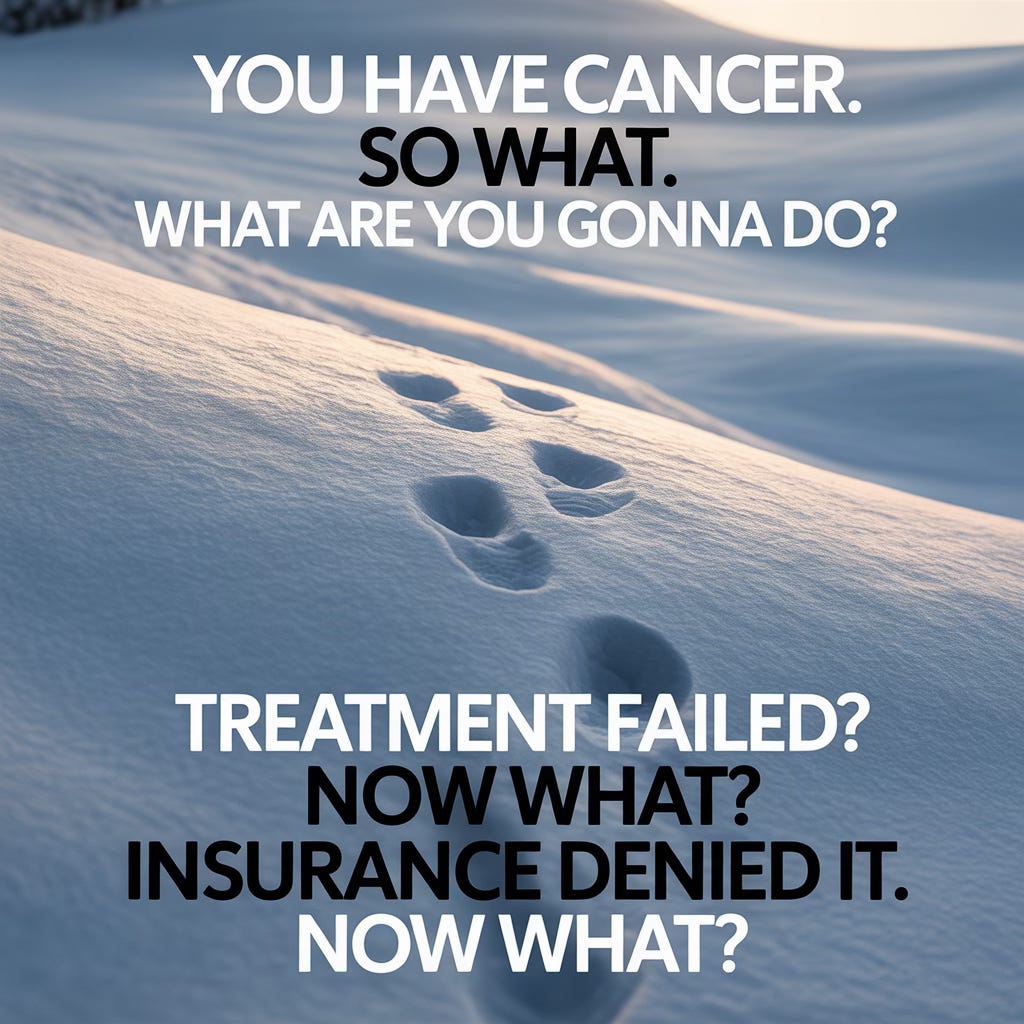How To Steal Time When It's Supposed to Be Running Out
How a father, athlete, and trainer changed the game
Miguel Rueda’s radiation oncologist did something unusual in 2015. He insisted that Miguel’s biopsy tissue be sent for genetic testing—not the standard germline testing that checks your inherited DNA, but sequencing of the tumor itself.
Miguel was 42. His PSA was 93. He had both typical prostate cancer cells and small cell cancer, a combination so rare it occurs in 2% of the 2% of men who get small cell prostate cancer. One urologist had already told him, “If it was me, I would just live out what I have left.”
But that tissue test revealed something critical: Miguel’s tumor had developed a BRCA2 mutation. Miguel himself didn’t carry this mutation in his germline DNA—his tumor had acquired it.
That mutation changed everything.
Buying Time Isn’t Stalling
Most people think of cancer treatment as pass/fail: the treatment works or it doesn’t. Miguel thinks differently.
“The whole time you’re buying time,” he said during our conversation. “The longer you can kick the can down the road, the more treatments that may become available, the more studies that are out there.”

He went through radiation first. His prostate responded, shrinking so much he could no longer do the planned radioactive pellet procedure. So he went back into radiation. Then chemo. Each treatment worked for a while, then stopped working. His numbers started climbing again. Another medication failed.
By conventional measures, he was running out of options.
But while Miguel stayed alive through these treatments, research was underway. A study was published about PARP inhibitors—medications originally created for ovarian cancer—working in men with hormone-dependent prostate cancer who had BRCA2 mutations.
Miguel had that mutation. In his tumor.
His radiation oncologist read that study and thought it might work. The medication wasn’t around when Miguel was first diagnosed. But Miguel had stayed alive long enough for those results to come out.
That was over six years ago. Miguel has been stable on that PARP inhibitor ever since.
This is what buying time actually means: you don’t know what treatment will emerge next year or the year after. You just need to be alive when it arrives.
The Insurance Fight
Miguel’s oncologist wanted to try the PARP inhibitor. Insurance denied it. The medication hadn’t been approved for prostate cancer yet. The cost: $13,000 per month.
“My oncologist wrote a letter trying to overturn the denial and it worked,” Miguel said. “But on social media, in the groups I belong to, I was finding other people whose physicians wanted to put them on it and their insurance denied it. They were reaching into their retirement savings to purchase the medications.”
The difference between Miguel and those other patients wasn’t the diagnosis, the mutation, or the treatment. The difference was a doctor willing to write an appeal letter and an insurance company that eventually overturned the denial.
Miguel knows he got lucky there. Not everyone does.
But here’s his thinking: If you’re staying alive through multiple treatments, you create various opportunities for something new to work. His case wasn’t unique—other men with BRCA2 mutations in their tumors could benefit from PARP inhibitors. He just needed to be alive when the option became available and have a doctor willing to fight for access.
The Decision That Made Everything Else Possible
Go back to that first decision: testing the tumor tissue, not just germline DNA.
“My radiation oncologist was insistent that they send my tissues from my biopsy for genetic testing, and that was not really common at the time,” Miguel said.
“What they had found was that my tumor had developed a BRCA2 mutation. I do not have this, but my tumor developed it.”
This matters because many cancer patients get germline genetic testing—checking whether they inherited mutations like BRCA1 or BRCA2 from their parents. That testing is valuable for family planning and understanding inherited cancer risk.
But tumor genetic testing examines the mutations the cancer itself has acquired. Your tumor can develop mutations you weren’t born with. Those acquired mutations might make you eligible for targeted therapies.
If Miguel had only received germline testing, it would have come back negative for BRCA2. He wouldn’t have been considered for PARP inhibitor therapy. His approach of buying time works only if you know what you’re buying time for.
So What, Now What
Miguel told me about walking up a snowy hill shortly after diagnosis. Everything felt terrible. The wet snow, the cold, the parking situation, the cancer, all of it.
“I got kind of halfway up the hill and I stopped. I don’t know why. I just kind of looked around and realized—it was a mindset. I’m not sure how I realized that, but then I just looked. The trees are covered with snow. It actually is kind of pretty. So I can be in awe of this view, or I could just be miserable.”
That’s when he started thinking: “So what? Now what?”
You have cancer. So what. What are you gonna do?
It’s not toxic positivity. It’s not pretending cancer isn’t terrible. It’s deciding that the situation doesn’t get to write the whole story. Miguel still had to walk up that hill. Cancer didn’t change that. But he got to choose whether he noticed the snow on the trees.
His favorite question became: “So what? Now what?”
Treatment failed. So what. Now what.
Insurance denied the medication. So what. Now what.
Numbers started climbing again. So what. Now what.
This mindset doesn’t guarantee anything. Miguel is clear about that. But it keeps you making decisions instead of waiting for cancer to decide for you.
What You Actually Need
Miguel’s approach isn’t complicated, but it requires specific things:
Information about your tumor, not just your genes. Ask your oncologist specifically about sequencing your tumor tissue to identify acquired mutations that might respond to targeted therapies. Your tumor might have mutations you weren’t born with.
Understanding that each treatment serves a purpose even when it fails. Miguel’s radiation worked, then stopped working. His chemo worked, then stopped working. Another medication failed entirely. Each treatment bought him months. Those months became years. Those years meant he was alive when the PARP inhibitor studies were published.
A doctor who will appeal. Miguel’s oncologist didn’t just prescribe the PARP inhibitor and shrug when insurance denied it. He wrote a letter explaining why the off-label use was appropriate based on Miguel’s tumor mutation and emerging research. That letter worked.
People who will help you stay alive. Miguel talks about learning to let people participate—friends who drove him to appointments, neighbors who organized food, colleagues who called just to listen. Buying time requires a team.
Nine years ago, Miguel got a phone call while driving his family to the San Francisco airport. The doctor said, “You have cancer and it’s not good.” That call didn’t determine how long Miguel had. It started a series of decisions about what to test, which treatments to try, which denials to fight, and which help to accept.
The timeline they gave him isn’t the timeline he’s living.
Questions Worth Asking Yourself
Have you asked your oncologist about tumor genetic testing? What mutations might your tumor have acquired that you weren’t born with?
When a treatment stops working, do you see it as failure or as having bought you time?
Does your oncologist know you expect them to appeal if insurance denies a treatment they recommend?
Who’s actually helping you stay alive right now? Who’s driving you, researching options, or just listening when you need to talk?
When you ask yourself “so what, now what?”—what answer comes up?
ManUpToCancer - Join Our Pack - https://manuptocancer.org/
Movember Foundation - https://us.movember.com/


